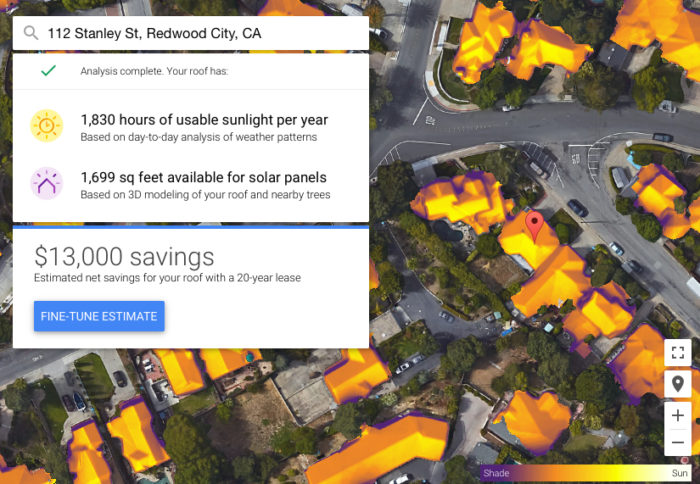
A pilot program just launched by Google gives homeowners in a few U.S. cities an estimate of how of their rooftops could be used for photovoltaic panels, and how much money they could save annually by installing them.
For now, Project Sunroof is available only for some addresses in and around three cities: San Francisco, Calif.; Fresno, Calif.; and Boston, Massachusetts. Plug in an address, and (if the address is listed in the database) up pops an analysis based on weather patterns and 3D modeling of the roof and nearby trees.
Users can tell the program what an average monthly power bill looks like, and then toggle between lease, loan and buy options to compare savings with each. The program also links users with solar installers in their area, according to an article in The Washington Post.
Helping allay fears about costs
The cost of solar panels has fallen dramatically in the last few years, but installing a residential system still isn’t cheap. So answering questions about costs is a major benefit of the project, The Post said. The software draws on information from banks and other financial institutions in predicting long-term savings, a Google public affairs officer told the newspaper.
For example, at 112 Stanley Street in Redwood City, California, modeling based on an aerial photograph of the neighborhood predicts that 1,699 square feet of rooftop could be used for solar panels, enough to support a solar array with a capacity of 4.5 kilowatts. The program compares 20-year savings when the panels are bought outright, leased from the installer, or bought with a loan. (In this instance, the program estimates savings of $23,000 when panels are bought outright, nearly twice as much as either of the other two options.)
Project Sunroof was developed by Google engineer Carl Elkin, who took advantage of a company program allowing employees to devote 20% of their work time to projects of their own choosing. The project could be expanded to other parts of the country in the months ahead.
“As a volunteer with the Boston-based solar program Solarize Massachusetts and a solar homeowner myself, I’ve always been surprised at how many people I encounter who think that ‘my roof isn’t sunny enough for solar,’ or ‘solar is just too expensive,'” Elkin writes in a post at Google’s Green Blog. ”Certainly many of them are missing out on a chance to save money and be green.”
If your address isn’t currently in an area served by the program, you can leave it with Google and you’ll receive a note when your area is covered.
PVWatts Calculator is similar
Anyone considering the installation of a solar system can already get basic information about the solar potential of a building site with the PVWatts Calculator, a program developed by the National Renewable Energy Laboratory.
It allows the entry of many more variables than does the Google program — such as the tilt of the roof, the predicted loss of the system and whether racks will be fixed or tracking — but it has less site-specific information.
It’s based on information for nearby weather stations, not a specific address, and without aerial photos to work with there’s no way to account for the size and orientation of the roof, or whether it’s affected by overhanging trees or nearby buildings.
Preliminary estimates that PVWatts produces would have to be fine-tuned with more sophisticated design tools. But the same could be said of estimates produced by Project Sunroof.
Weekly Newsletter
Get building science and energy efficiency advice, plus special offers, in your inbox.














One Comment
PV Watts
The PV WATTS site is fabulous. However there is something suspicious about the financing calculations. The basic solar info, system production, etc. are bang on. Try your own array against it, it is very accurate. The problem is that the actual cost per kwh that it spits out, is unchangeably based on 100% loan at 7.5% interest over 25 years! And an extra 2 cents kwh for maintenance etc. This distorts the final figures. I like the google version since it will give you a choice of loan, or cash etc. Notice the incredible difference in savings. I like to use 3% as an interest figure. At that rate your monthly payments will be about the same or less than grid prices. The system will be paid off in 20 years and you have perhaps 15 years left of free electricity. Anyway, a loud and constant conversation needs to continue about the money side of solar. The mechanical side has been hashed out quite well.
Log in or create an account to post a comment.
Sign up Log in